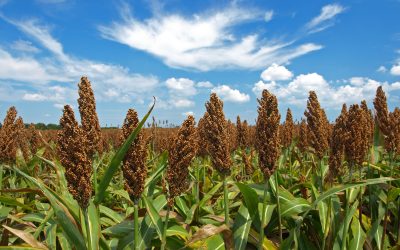You know healthy soil is more productive, but have you ever considered how the quality of your soil impacts your crop’s fertility? You may have heard that yield potential is built from the ground up, and that’s because the soil is the plant’s lifeline for accessing vital nutrients and water that fuel crop health. Let’s dive into five ways you can build soil health to improve plant nutrient uptake.
- Mitigate Soil Compaction for Enhanced Root Growth and Nutrient Uptake
If you’ve built a solid fertility program, but notice that your crops still seem to be nutrient deficient in season, soil compaction could be an issue. Compacted soils are often the result of using heavy equipment when soil conditions aren’t ideal. The weight of the equipment compresses the soil particles, reducing pore spaces that are vital for oxygen exchange and water movement.
Compacted soils can lead to hard pans just below the topsoil. These dense soil layers restrict root growth, limiting access to soil nutrients. Nutrients below the hardpan are unavailable for plant uptake. Hardpans can also reduce water infiltration into the soil, which can lead to plant stress.
Research has shown that high levels of soil compaction have adverse effects on corn growth, including:
- Diminished nutrient uptake: Nitrogen absorption reduced by 13.5%, potassium by 51.4% and magnesium by 50.4%1
- Less plant biomass: 27.1% reduction in shoot elongation and 67.8% less leaf area1
- Smaller root masses: Fresh and dry root mass volume reductions of 39.1% and 37.8%, respectively1
- Unlock Nutrient Potential By Optimizing Soil pH
Soil pH is one of the most critical soil characteristics to manage for plant nutrient uptake. Ideal soil pH is slightly acidic (between 6.0 and 6.5), because many of the essential plant nutrients are at their maximum availability in the soil at these pH levels.
Low pH can limit the uptake of many macronutrients and secondary nutrients, including phosphorus, potassium and sulfur. On the other hand, high pH often affects the availability of micronutrients, including manganese, copper and zinc.
Soil testing can help you determine your soil’s pH. If testing reveals pH is out of the ideal range for the crop you’re growing, there are management options. Applying lime is a common practice for increasing soil pH, although it may take one to two years to see results. Gypsum or elemental sulfur applications can help reduce soil pH, but these soil amendments can also take up to two years to take effect.
Source: Illinois Soy Advisor. Soil pH levels where essential crop nutrients are most available.
- Make the Most of Your Soil’s Microorganisms
Soil biology has become a popular topic in recent years, and biological inputs are one of the fastest-growing segments in the ag market today. There is a lot of research on the benefits of a diverse and healthy soil microbiome. Beneficial microorganisms, including plant-growth-promoting rhizobacteria (PGPR) and mycorrhizal fungi, can help improve soil nutrient uptake in several ways.
Microorganisms play a crucial role in the process of nutrient cycling. They help mineralize organic nutrients, such as phosphorus, that are typically locked in the soil and unavailable for plant uptake. Soil bacteria convert unavailable phosphorus into a plant-available form that crops can use.
Soil microorganisms also break down organic material in the soil, including crop residue, which releases nutrients such as nitrogen, phosphorus, and potassium back into the soil. The more active these microorganisms are, the faster they’re able to decompose organic material into useful plant nutrients.
Rhizobium bacteria help legume crops, such as soybeans, fix atmospheric nitrogen, building the soil’s supply of nitrogen for the current and subsequent crops.
Microorganisms don’t just help increase the supply of plant-available nutrients—they can also help plants harness those nutrients. For example, mycorrhizal fungi form symbiotic relationships with crop roots, extending their surface area and reach for maximum nutrient uptake.
- Boost Soil Organic Matter to Warehouse Essential Nutrients
Soil organic matter (SOM) is arguably the most critical component of healthy soil. As organic matter in the soil breaks down through chemical and physical processes, essential plant nutrients like nitrogen, phosphorus and sulfur are slowly and steadily released. A soil containing 3% organic matter contains approximately 3,000 pounds of nitrogen per acre; however, only a small portion (30-100 pounds) may be available to plants in any given year, depending on decomposition rates.2
Another benefit of high SOM is that it increases a soil’s cation exchange capacity (CEC). Soils with a higher CEC can hold positively charged nutrients, such as calcium, magnesium and potassium, better, reducing the risk of these nutrients leaching out of the soil. So, SOM supplies, stores and retains essential plant nutrients, ultimately contributing to better plant nutrient uptake.
But that’s not all. Soils high in organic matter typically have better structure, water infiltration and aeration, all of which indirectly enhance nutrient availability. In addition, high-organic-matter soils encourage root growth and penetration, giving plants more access to nutrients.
- Manage Soil Moisture to Improve Plant Nutrient Uptake
Soil moisture plays a vital role in plant nutrient uptake. Water in the pore spaces between soil contains dissolved nutrients that can move into plant roots by diffusion or mass flow. Less soil moisture means fewer dissolved nutrients available for plant uptake.
Low soil moisture levels also reduce transpiration rates in plants, meaning less water and nutrients are pulled into the plant from the soil. Uneven moisture distribution in the soil can lead to localized nutrient imbalances, which can affect crop growth and development. In your field, this might manifest as specific areas that are stunted or exhibiting the visual symptoms of a nutrient deficiency.
Start Building Soil Health to Boost Profitability
Soil health is complex, but understanding how its different facets work together to support more productive crops is one of the keys to boosting farm profitability. At UpTerra, we’ve developed water-enhancing technology for irrigation systems that improves soil health over time by:
- Facilitating more even moisture distribution in the soil
- Supporting more diverse and active soil microbial populations
- Promoting healthy root growth, which improves aeration and water infiltration
Get in touch with a member of our team to learn more and start replenishing your soil’s health.
References
1 Olubanjo, OO and Yessoufou, MA. Effect of soil compaction on the growth and nutrient uptake of Zea Mays L. 2019. Sustainable Agriculture Research. Vol. 8:2.
2 USDA. NRCS. Healthy soils are high in organic matter.



